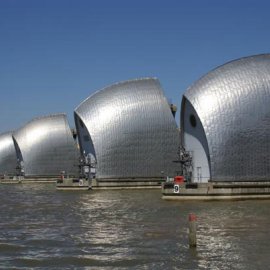The Hard Edge
-
English
-
ListenPause
[intro music]
Welcome to World Ocean Radio…
I’m Peter Neill, Director of the World Ocean Observatory.
Our traditional approach to potential inundation by water has been the hard edge. It represents our cultural assumption that Nature is there to serve our needs and, when necessary, to be engineered to that advantage. You see hard edges everywhere: sea walls; dikes and levees; riprap erosion controls; dams; and canals that artificially connect water bodies for transport by ship, for hydropower, or for redirection away from alternative development.
Indeed, we have created large bureaucracies – water boards and the Army Corps of Engineers in the United States for example – with the mission to protect us from the encroachment of water, to shield ports and harbors against storm and surge, to facilitate the most efficient marine transportation, and to otherwise manage the environment, lakes, inland waterways, and coastwise, to human advantage as defined by the financial exigencies of the time.
The fate of coastal wetlands is another blatant example of hard over soft. Once massive buffers against storm incursion, wetlands served human needs additionally through complementary cultivation of hay for fodder for salt-water farms. But as those farms gave way to more concentrated settlement and sprawl, the marshes were first ditched to control pesky mosquitoes that annoyed suburban residents, a disruption of the natural arrangement that increased erosion and drained the buffer zone, followed thereafter by hard edges behind which could be deposited dredge spoils, construction debris, and other unnatural material that transformed the soft soil into hard ground on which could be constructed more housing, parking lots, shopping malls, and manufacturing plants – all uses antithetical to Nature’s original intent. You could describe a similar history for the destruction of coastal mangroves in other areas around the world.
Highways are hard edges. In southern New England where I once lived, the major north-south interstate highway that extends from Florida to Maine was built to follow a coastal route that created a concrete wall between the shore and the entire land mass and marine system upstream to the point that the entire natural watershed was blocked and re-directed to three cement conduits beneath the highway, not only interrupting and concentrating the natural drainage, but also the animal migration and surface water distribution that sustained the historical ecosystem resulting in all sorts of changes, disruptions, and negative environmental consequences to the region.
More modern examples of hard edge thinking also include such things as the Thames Barrier designed to protect London, England, from flooding. According to Wikipedia, the structure is built across a 1,710 foot wide stretch of the Thames, dividing the river into four 200 foot and two 100 foot navigable spans. The floodgates across the openings are circular segments in cross section that operate by rotating, raised to allow under spill for operators to control upstream levels and complete a 180 degree rotation for maintenance. All the gates are hollow and made of steel up to 1.6 inches thick. The gates fill with water when submerged and empty as they emerge from the river. The four large central gates are 66 feet high and weigh 3,700 tons. In January 2013 in a letter to the London Times newspaper, a former member of the Thames Barrier Project Management Team, Dr. Richard Bloore, stated that the flood barrier was not designed with increased storm and sea level rise in mind, and called for a new barrier to be looked into immediately.
Finally, the Netherlands has long used the hard edge concept to protect the almost two-thirds of its national territory that is at or below sea level and otherwise susceptible to flooding by three major rivers: the Rhine, Meuse, and Scheldt. Before 1000 AD, the Dutch began to protect their coastal areas with earthen dykes, followed through the centuries by timber walls, followed by higher structures reinforced by crushed rock and cement, covered over by earth on which sheep continue to graze. But flood control engineering was soon augmented necessarily by the need for increased protection and the Dutch innovated radically with the construction of an enormous barrier system that closed the natural opening to the ocean and transformed the Zuiderzee into the IJsselmeer, literally from a sea to an inland lake. This was followed in the 1990s by the Delta Works, an even larger storm surge protection system that today, in the face of projected sea level rise, is nonetheless considered inadequate for the future and has sent the Dutch engineers back to the drawing board.
Hard problems, hard thinking, hard edges: might there be another way?
We will discuss these issues, and more, in future editions of World Ocean Radio.
WORLD OCEAN RADIO IS DISTRIBUTED BY THE PUBLIC RADIO EXCHANGE AND THE PACIFICA NETWORK FOR USE BY COLLEGE AND COMMUNITY RADIO STATIONS WORLDWIDE. FIND US WHEREVER YOU LISTEN TO YOUR FAVORITE PODCASTS AND AT WORLD OCEAN OBSERVATORY DOT ORG.
This week with "Hard Edges" we kick off a 7-part series dedicated to the ocean edge, exploring what takes place there, from the real to the symbolic. In this episode we'll take listeners through the history of the industrial development and management of ports, wetlands and watersheds. And we'll share some modern examples of hard-edge engineering and the challenges for existing structures in the face of projected sea level rise, storm surge and coastal flooding.
About World Ocean Radio
World Ocean Radio provides coverage of a broad spectrum of ocean issues from science and education to advocacy and exemplary projects. World Ocean Radio, a project of the World Ocean Observatory, is a weekly series of five-minute audio essays available for syndicated use at no cost by college and community radio stations worldwide.
Image
The Thames Barrier, U.K.
- Login to post comments



